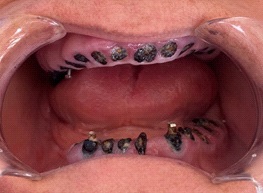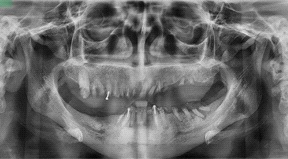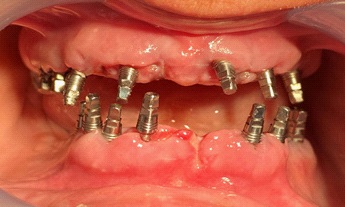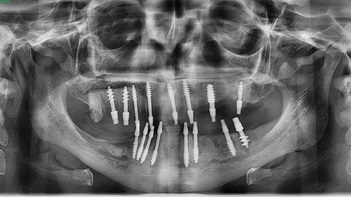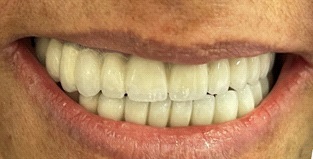
Journal of Clinical Images and Medical Case Reports
ISSN 2766-7820
Case Report - Open Access, Volume 3
Full mouth rehabilitation with immediate loading implants
Abdulwahab I Al-kholani1*; Soumia A Al-Maghreby2
1 Professor of Restorative Dentistry, Dental Implant Consultant, Faculty of Dentistry, Sana’a University, Sana’a, Yemen.
2 Professor, Abdulwahab Al-kholani Dental Center, Sana’a, Yemen.
*Corresponding Author: Abdulwahab Ismail Al-kholani
Conservative Department, Faculty of Dentistry,
Sana’a University Yemen.
Email: prof_kholani@yahoo.com
Received : Dec 24, 2021
Accepted : Mar 04, 2022
Published : Mar 11, 2022
Archived : www.jcimcr.org
Copyright : © Al-kholani AI (2022).
Abstract
Implant-supported fixed prosthodontics are successful treatment modalities that can be used for full mouth rehabilitation. According to the patient’s wishes, great concern was given to the esthetic and function. The purpose of this study is to report the clinical outcomes of fullmouth rehabilitation using flapless implant placement and immediate loading prosthesis in patients with the complete destruction of permanent dentition in which 16 single piece implants were placed in the extraction sockets eight implants in each jawand functionally loaded with both maxillary and mandibular fixed prosthesis. This is considered an ideal method and gives successful treatment results, with a significant improvement of oral function, esthetic, and quality of life.
Keywords: immediate loading implant; full-mouth rehabilitation; implant-supported fixed prosthodontics.
Citation: Al-kholani AI, Al-Maghreby SA. Full mouth rehabilitation with immediate loading implants. J Clin Images Med Case Rep. 2022; 3(3): 1730.
Introduction
Implant-supported fixed prosthodontics is the treatment of choice that can be used for full mouth rehabilitation. Modern advances in implantology are intended to provide prosthetic restorations with excellent esthetic and functional outcomes. The number of implants used in fully edentulous patients depends on the height, width, and quality of bone available. Other factors either removable or fixed restoration play a role in determining the total number of implants [1,2]. Traditional Branemark’s system delayed loading protocol leaves the patient without temporary restoration for several months. This obvious drawback of the procedure is usually rejected by the patient. Over the last decade, newer immediate loading protocols have been demonstrated to reduce the treatment time [7,8]. Since the cortical walls around the extraction site are stable and survive at the time of extraction, placement of implants into fresh extraction sockets is more successful than placement after several months [2]. Two different approaches were used with immediate loading of dental implants. The first one is on the principle of compression screw, whereas the other is on the cortical anchorage of thin screw implants (Bicortical Screw [BCS) [3,4].
Tooth loss causes deterioration in chewing, speech functions, and aesthetic concerns [5]. Many factors affect the prevalence of edentulism between different countries and regions, such as education, economic status, access and opportunity to oral healthcare, lifestyle, and attitudes to dental care [7].
Currently, the majority of completely edentulous patients choose fixed implant treatment instead of removable dentures. The introduction of dental implants has improved the quality of life for edentulous patients. The implant-supported fixed prosthodontics may be the treatment of choice when there isa favorable ridge.
Assessments of rehabilitation treatments must consider patients’ opinions as a variable of treatment success [9].
Case report
A 50-year-old female with a history of badly destructed teeth in the lower and upper jaws was attended our dental center for full mouth rehabilitation. The patient’s chief complaint of not being able to eat properly and being uncomfortable with the aesthetic appearance (Figure 1).
The remaining teeth are hopeless and must be removed (Figures 2 and 3). The patient was systematically fit and there was no significant medical history. This case report focuses on the use of single-piece immediate dental implants in a full-mouth rehabilitation patient.
Considering the presented situation, standard [1] protocol was selected for full mouth reconstruction. Sixteen single-piece implants were placed in the extraction sockets eight implants in each jaw (Figures 4 and 5) and functionally loaded with both maxillary and mandibular fixed prosthesis.
Traditional impression procedure was performed. A few days later metal try-in was performed in the mouth and evaluating their passive fit, they were returned to the laboratory for final adjustment. In the next visit, the final fixed prosthesis was cemented temporarily with Eugenol-free temporary cement for a few days allowing the patient to test the situation. In the last visit, permanent cementation for the fixed prosthesis was performed (Figure 6). The patient was instructed to keep good oral hygiene. The patient was advised to return for regular followups which were every 3 months during the first year, and then every six months.
Discussion
Single piece dental implant-supported fixed prosthodontics used for the treatment of completely edentulous patients is considered the treatment of choice [1]. The advantages of this type of treatment derive from the characteristics of this type of implant [4]. Since the cortical walls around the extraction site are still intact at the time of extraction, placement of immediate dental implants into fresh extraction sockets is a successful method [3].
Declarations
Declaration of patient consent: The authors certify that they have obtained all appropriate patient consent forms. In the form, the patient has given her consent for her images and other clinical information to be reported in the journal. The patients understand that her name and initials will not be published.
Conflict of interest: No potential conflict of interest is relevant to this article, all authors declare that no financial and personal relationships with other people or organizations could inappropriately influence (bias) their work.
References
- Yadav RS, Sangur R, Mahajan T, Rajanikant AV, Singh N, Singh R. An alternative to conventional dental implants: Basal implants. Rama Univ J Dent Sci. 2015; 2: 22 28.
- Kopp S, Kopp W. Comparision of immediate vs. delayed basal implants. J Maxillofac Oral Surg. 2008; 7: 116 122.
- Narang S, Narang A, Jain K, Bhatia V. Multiple immediate implants placement with immediate loading. J Indian Soc Periodontol. 2014; 18: 648 650.
- Ghalaut P, Shekhawat H, Meena B. Full-mouth rehabilitation with immediate loading basal implants: A case report. Natl J Maxillofac Surg. 2019; 10: 91-94.
- Emami E, de Souza RF, Kabawat M, et al. The impact of edentulism on oral and general health. Int J Dent 2013; 2013: 498305.
- López CS, Saka CH, Rada G, et al. Impact of fixed implant supported prostheses in edentulous patients: Protocol for a systematic review. BMJ Open. 2016; 6: e009288.
- Balshi SF, Wolfinger GJ, Balshi TJ. A prospective study of immediate functional loading following the teeth in a day protocol: A case series of 55 consecutive edentulous maxillas. Clin Implant Dent Rel Res. 2005; 7: 24–31.
- Maló P, Rangert B, Nobre M. “Allon-Four” immediate-function concept with Brånemark System R implants for completely edentulous maxillae: A 1 year retrospective clinical study. Clin Implant Dent Relat Res. 2005; 7: S88–S94.
- Awad MA, Feine JS. Measuring patient satisfaction with mandibular prostheses. Community Dent Oral Epidemiol. 1998; 26: 400–405.


